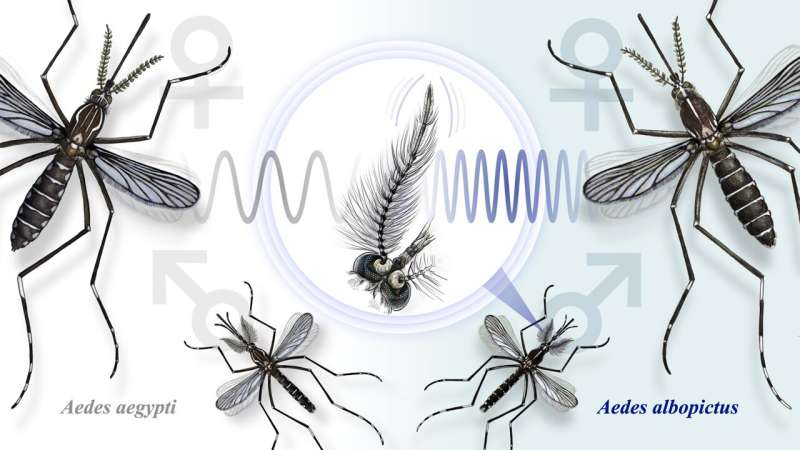This article has been reviewed according to Science X's editorial process and policies. Editors have highlighted the following attributes while ensuring the content's credibility:
fact-checked
peer-reviewed publication
trusted source
proofread
How listening for the right buzz keeps mosquitoes from mating with the wrong species

Researchers from Nagoya University in Japan have uncovered how the yellow fever mosquito and Asian tiger mosquito distinguish their own species from others. Males from these species listen for the specific frequencies of sound made by the flapping wings of females and use these sounds to select their own species.
These findings, published in iScience, have implications for developing innovative mosquito control strategies using artificial flight sounds.
The primary vectors for potentially deadly diseases including dengue fever and Zika fever are the yellow fever mosquito (Aedes aegypti) and Asian tiger mosquito (Aedes albopictus), which can transmit the viruses when they drink a blood meal.
"In the past few decades, the territories of the two types of mosquitos have increasingly overlapped," said Dr. Matthew Su, joint corresponding author of the study. "Mainly at dusk, male Aedes mosquitoes form a swarm, a large group of flying males waiting for fertile females to fly in.
"When a female enters the group, the male uses his excellent hearing to hear her wing sound, approach her, and attempt to mate. But females of other species could enter the group too, so we became interested in how males avoid mating with the wrong species."
The research team installed microphones in mosquito breeding cages to measure the frequencies of wingbeats of males and females and compared them between species. They discovered that both male and female Asian tiger mosquitoes had higher wing sound frequencies than yellow fever mosquitoes.
They theorized that this difference explained how mosquitoes avoid mating with the wrong species. When they created synthetic female wing sounds and played them back to male mosquitoes, they noticed that male Asian tiger mosquitoes consistently responded to higher frequencies of sound than yellow fever mosquito males.
"We believe the males have optimized the vibratory properties of their 'ears' to match the frequencies of females of the same species," Professor Azusa Kamikouchi, the joint corresponding author, said. "This suggests that males are finely tuned to the specific wingbeat frequencies produced by females of their species."
"Mosquito mating depends on male hearing of female sounds," Su added. "Even though the difference in female sounds may sound small at 40 Hz, for mosquitoes—and humans in fact—this gap is huge. They modulate their hearing function via signals sent from their brains to their ears to listen for the right frequency. Humans actually do something similar to help tune out background noise to sleep or hear a friends' voice in a noisy bar."
When mosquito populations reach undesirably high levels, traps are used to control them. Oviposition traps work by attracting females to lay eggs and then killing them. Attractants are often used to lure female mosquitoes to the traps, but these new findings suggest that by adding flight sounds, males could also be trapped.
"I could see our research being used to combine oviposition and sound traps," Su said. "Oviposition traps exist, but they mostly catch females, so we thought why not capture males at the same time? It's good to plan ahead for potential outbreaks especially as the effects of climate change are increasing the number of people affected by mosquitoes."
The researchers stress that although combined oviposition and sound traps could be used to prevent mosquitoes from reproducing and eliminate them, this would not be a desirable outcome.
Mosquitoes have important environmental roles as pollinators for plants and food for amphibians, which would be disrupted by their removal from the ecosystem. Instead, they hope to use trapping to control populations in the event of a population explosion, something which risks an increase in transmission of mosquito-borne diseases.
"Elimination may not be a good idea because we don't know the effects on the ecosystem. Instead, we feel that limited biocontrol is better," Dr. Su explained. "Ultimately, we will have to live together with mosquitoes, ideally separately. Therefore, we have to understand them and drive numbers down to levels where diseases are less likely to be transmitted."
More information: YuMin M. Loh et al, Differences in male Aedes aegypti and Aedes albopictus hearing systems facilitate recognition of conspecific female flight tones, iScience (2024). DOI: 10.1016/j.isci.2024.110264
Journal information: iScience
Provided by Nagoya University



















